Where did Greeks and Romans eat? It depends on where you stood in the social pyramid. A vast gulf existed in Greek and Roman cities between a small class of very wealthy citizens and the impoverished masses. Between them stood a small “middle class” of free citizens who provided services for the wealthy or owned small businesses. A large population of slaves labored in homes, shops, and public offices to keep the city running.
Those at the top of the pyramid lived in huge mansions staffed by dozens of slaves who looked after their every need, including their meals. Food was prepared and cooked in indoor kitchens by a full-time staff of slaves and served in a dining room where family and guests reclined on couches and enjoyed every delicacy that human minds could conceive.

Reclining at dinner in a wealthy household
Those who provided services to the elites or owned small businesses lived in smaller houses or apartments where they may or may not have had cooking facilities. Many would have owned a few slaves to tend their homes or work in their shops, but cooks would have been rare at this level. Nonperishable foods like bread, olives, wine, and dried fruits and nuts were the primary elements of their diet, supplemented by fresh fruits and vegetables during the harvest season and an occasional meat dish. Those who worked closely with a wealthy patron might also be invited to a higher-quality meal now and then. Members of private associations also enjoyed meals together on occasion, whether in rented quarters or in a hall owned by the association.

An assortment of dried and fresh foods that might have been available for use at home
The great mass of the population lived in small rooms or apartments scattered around the city where they had no access to cooking facilities. Those who were able to earn a little money ate at small food shops like the one shown below. Such shops were scattered all around the city–over 80 have been excavated in Pompeii alone. Various types of “fast food” were sold from clay jars anchored into the countertop, including dried fruits and nuts, olives, pottages and stews, salted fish, cheeses, and mulled wines.
Most of these shops sold food “to go,” but some had room for a few tables where guests could socialize, gamble, carouse, and arrange sexual liaisons. Properties of this sort had a poor reputation among the upper class citizens, who resorted to them only in times of necessity–for example, when traveling through a strange city like the characters in my novels. Young men from the upper class also hung out at such places from time to time, like Gaius in my novels, but their elders discouraged it.

Fast food shop (in Latin, taberna, poppina, or thermopolium) in Herculaneum, Italy
Slave diets varied from house to house, with some being well cared for and others living close to starvation. Most probably ate whatever lay at hand, with little variety in their diet. Those who worked in the kitchen of a wealthy household likely ate the leftovers from their master’s meal and perhaps even shared them with other slaves on occasion, as depicted in my novels. In fact, slaves in a wealthy household often ate better than poor free citizens. At a minimum, most slaves could count on having enough food to survive, unlike the homeless beggars who could be found in every city.
One final source of food in a Greek or Roman city was the sacrificial meat that was distributed to the population during sacred festivals, as depicted several times in my novels. The carcasses of animals that were offered in sacrifice would be boiled or roasted and the meat passed out to all who were present, regardless of social class. For the poor masses, this was one of the few times when many of them would have eaten meat. Even poor beggars might receive enough to keep them alive at such festivals.



